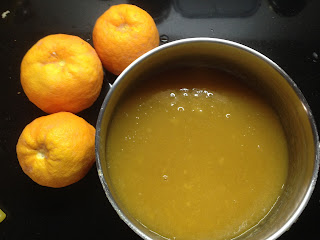Pressure Cooker Marmalade
Making this marmalade in a pressure cooker reduces the cooking time compared to the conventional method. Firstly, the peel is not boiling away for ages on the stove, so less fluid is required. Consequently (secondly), when it's time to add the sugar, the setting point is reached much more quickly because there isn't all that excess water to boil off! Thirdly, the method also does away with the fiddly procedure of tying the pith and pips in a muslin bag. So you must be realising that this is my preferred method of making marmalade.
Just a note, I cook at 15 lbs pressure as I live at 650 m altitude. 10 or
12 lbs may be sufficient at sea level.
Ingredients
1 kg (2lbs) oranges - Seville are best - you could
substitute other citrus fruits
1 litre (2 pints) water
juice only of 2 lemons
2 kgs (4lbs) white granulated sugar
- Cut the oranges and lemons in half, squeeze them and reserve the juice.
- Pull any remaining flesh from the insides of the oranges and lemons and scrape out most of the pith. Discard the lemon skins. Place the flesh pieces, pith and pips into a pressure cooker together with half the water. Cook this at 15 lbs pressure for 15 minutes. Once the oddbits are cooked and pressure released, tip the contents of the pressure cooker through a sieve, pushing as much through as possible with a spoon. The puree that passes through the sieve can now go into the preserving pan.
 |
| The pith and pips have been tipped through a sieve and will be pushed through a little more with a spoon |
 |
| This is what passes through the sieve and goes into the preserving pan |
- Cut the orange peel into fine slices, depending on preference, i.e fine cut or thick cut marmalade. It is worth taking some care on cutting the peel evenly as this will contribute greatly to the overall appearance of the marmalade.
- Next cook the prepared orange peel in the other half of the water together with the orange and lemon juice. 15 lbs for 15 minutes. Once cooked, do not release the pressure quickly as this may cause the peel to break up. Preferably, allow pressure to equalise as the cooker cools. Add the cooked orange peel to the puree in the preserving pan.
- Now add the sugar to the preserving pan and bring to the boil gently, stirring to prevent sticking.
- Once the sugar is fully dissolved, bring to rolling boil and test every 5 minutes until setting point achieved. Ensure peel is not burning onto pan by gently running wooden spoon over bottom periodically.
- Once setting point is reached, turn out heat. Allow to rest for 5 minutes and then place in warm sterilised jars. Seal down whilst still hot so that vacuum forms upon cooling.
 |
| This is the beautiful tree that gave us our Seville oranges this year |





Comments
Post a Comment